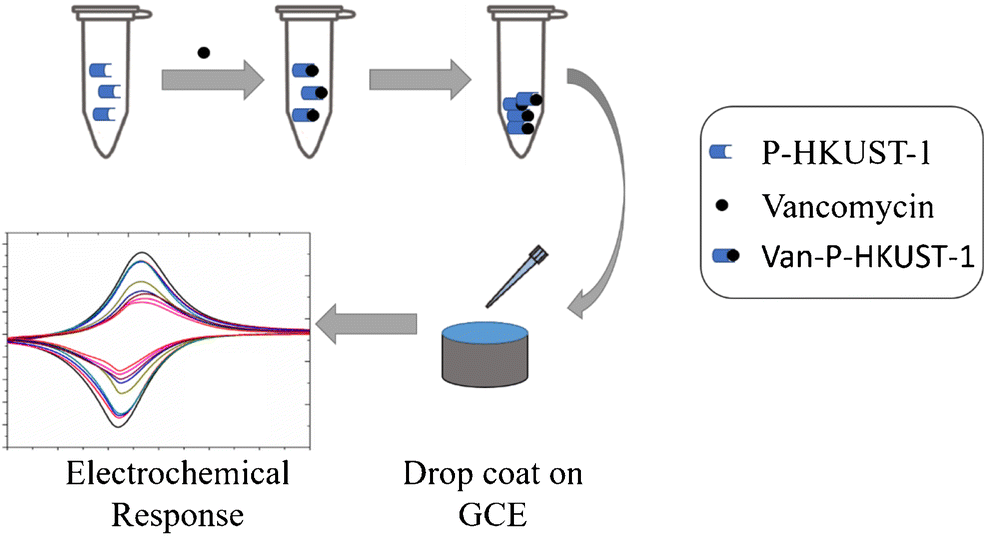当前位置:
X-MOL 学术
›
Microchim. Acta
›
论文详情
Our official English website, www.x-mol.net, welcomes your
feedback! (Note: you will need to create a separate account there.)
A poly(acrylic acid)-modified copper-organic framework for electrochemical determination of vancomycin
Microchimica Acta ( IF 5.3 ) Pub Date : 2020-01-01 , DOI: 10.1007/s00604-019-4015-3 Atal A S Gill 1 , Sima Singh 1 , Nikhil Agrawal 1 , Zondi Nate 1 , Tirivashe E Chiwunze 1 , Neeta Bachheti Thapliyal 1, 2 , Ruchika Chauhan 1 , Rajshekhar Karpoormath 1
Microchimica Acta ( IF 5.3 ) Pub Date : 2020-01-01 , DOI: 10.1007/s00604-019-4015-3 Atal A S Gill 1 , Sima Singh 1 , Nikhil Agrawal 1 , Zondi Nate 1 , Tirivashe E Chiwunze 1 , Neeta Bachheti Thapliyal 1, 2 , Ruchika Chauhan 1 , Rajshekhar Karpoormath 1
Affiliation

|
A copper(II) benzene-1,3,5-tricarboxylate (BTC) metal-organic framework (MOF) was modified with poly(acrylic acid) (PAA) and then used in an electrochemical sensor for vancomycin. The MOF, synthesized via a single-pot method, has enhanced solubility and dispersibility in water as compared to HKUST-1 but without compromising its crystallinity and porosity. The MOF was placed on a glassy carbon electrode (GCE) where it shows enhanced electrocatalytic properties. This is assumed to be due to the presence of the poly(acrylic acid) that forms a network between various HKUST-1 crystals through dimer formation between the carboxy groups of BTC and PAA. This also led to better dispersion of the MOF and to improved interaction between MOF and vancomycin. The structural, spectral and electrochemical properties of the MOFs and their vancomycin complexes was characterized. The modified GCE is shown to be a viable tool for electrochemical determination (best at a working potential of 784 mV vs. Ag/AgCl) of the antibiotic vancomycin in spiked urine and serum samples. Response is linear in the 1–500 nM vancomycin concentration range, and the detection limit is 1 nM, with a relative standard deviation of ±4.3%. Graphical abstract Schematic representation of a method for determination of vancomycin. Poly(acrylic acid) modified HKUST-1 (P-HKUST-1) forms a complex with vancomycin [Van-P-HKUST-1] which is coated over glassy carbon electrode (GCE). The decrease in peak current is recorded as response to vancomycin via cyclic voltammetry.
中文翻译:

用于电化学测定万古霉素的聚(丙烯酸)修饰的铜-有机骨架
铜 (II) 苯-1,3,5-三羧酸 (BTC) 金属有机骨架 (MOF) 用聚丙烯酸 (PAA) 改性,然后用于万古霉素的电化学传感器。与 HKUST-1 相比,通过单锅法合成的 MOF 在水中的溶解性和分散性增强,但不影响其结晶度和孔隙率。MOF 被放置在玻璃碳电极 (GCE) 上,在那里它显示出增强的电催化性能。这被认为是由于聚(丙烯酸)的存在,通过 BTC 和 PAA 的羧基之间的二聚体形成,在各种 HKUST-1 晶体之间形成网络。这也导致了 MOF 更好的分散并改善了 MOF 和万古霉素之间的相互作用。结构性,表征了 MOF 及其万古霉素复合物的光谱和电化学性质。改进的 GCE 被证明是一种可行的工具,用于电化学测定加标尿液和血清样品中的抗生素万古霉素(最佳工作电位为 784 mV 与 Ag/AgCl)。响应在 1–500 nM 万古霉素浓度范围内呈线性,检测限为 1 nM,相对标准偏差为 ±4.3%。图形摘要 万古霉素测定方法的示意图。聚(丙烯酸)修饰的 HKUST-1 (P-HKUST-1) 与万古霉素 [Van-P-HKUST-1] 形成复合物,后者涂覆在玻璃碳电极 (GCE) 上。通过循环伏安法将峰值电流的降低记录为对万古霉素的反应。改进的 GCE 被证明是一种可行的工具,用于电化学测定加标尿液和血清样品中的抗生素万古霉素(最佳工作电位为 784 mV 与 Ag/AgCl)。响应在 1–500 nM 万古霉素浓度范围内呈线性,检测限为 1 nM,相对标准偏差为 ±4.3%。图形摘要 万古霉素测定方法的示意图。聚(丙烯酸)修饰的 HKUST-1 (P-HKUST-1) 与万古霉素 [Van-P-HKUST-1] 形成复合物,该复合物涂覆在玻璃碳电极 (GCE) 上。通过循环伏安法将峰值电流的降低记录为对万古霉素的反应。改进的 GCE 被证明是一种可行的工具,用于电化学测定加标尿液和血清样品中的抗生素万古霉素(最佳工作电位为 784 mV 与 Ag/AgCl)。响应在 1–500 nM 万古霉素浓度范围内呈线性,检测限为 1 nM,相对标准偏差为 ±4.3%。图形摘要 万古霉素测定方法的示意图。聚(丙烯酸)修饰的 HKUST-1 (P-HKUST-1) 与万古霉素 [Van-P-HKUST-1] 形成复合物,后者涂覆在玻璃碳电极 (GCE) 上。通过循环伏安法将峰值电流的降低记录为对万古霉素的反应。检出限为1 nM,相对标准偏差为±4.3%。图形摘要 万古霉素测定方法的示意图。聚(丙烯酸)修饰的 HKUST-1 (P-HKUST-1) 与万古霉素 [Van-P-HKUST-1] 形成复合物,后者涂覆在玻璃碳电极 (GCE) 上。通过循环伏安法将峰值电流的降低记录为对万古霉素的反应。检出限为1 nM,相对标准偏差为±4.3%。图形摘要 万古霉素测定方法的示意图。聚(丙烯酸)修饰的 HKUST-1 (P-HKUST-1) 与万古霉素 [Van-P-HKUST-1] 形成复合物,后者涂覆在玻璃碳电极 (GCE) 上。通过循环伏安法将峰值电流的降低记录为对万古霉素的反应。
更新日期:2020-01-01
中文翻译:

用于电化学测定万古霉素的聚(丙烯酸)修饰的铜-有机骨架
铜 (II) 苯-1,3,5-三羧酸 (BTC) 金属有机骨架 (MOF) 用聚丙烯酸 (PAA) 改性,然后用于万古霉素的电化学传感器。与 HKUST-1 相比,通过单锅法合成的 MOF 在水中的溶解性和分散性增强,但不影响其结晶度和孔隙率。MOF 被放置在玻璃碳电极 (GCE) 上,在那里它显示出增强的电催化性能。这被认为是由于聚(丙烯酸)的存在,通过 BTC 和 PAA 的羧基之间的二聚体形成,在各种 HKUST-1 晶体之间形成网络。这也导致了 MOF 更好的分散并改善了 MOF 和万古霉素之间的相互作用。结构性,表征了 MOF 及其万古霉素复合物的光谱和电化学性质。改进的 GCE 被证明是一种可行的工具,用于电化学测定加标尿液和血清样品中的抗生素万古霉素(最佳工作电位为 784 mV 与 Ag/AgCl)。响应在 1–500 nM 万古霉素浓度范围内呈线性,检测限为 1 nM,相对标准偏差为 ±4.3%。图形摘要 万古霉素测定方法的示意图。聚(丙烯酸)修饰的 HKUST-1 (P-HKUST-1) 与万古霉素 [Van-P-HKUST-1] 形成复合物,后者涂覆在玻璃碳电极 (GCE) 上。通过循环伏安法将峰值电流的降低记录为对万古霉素的反应。改进的 GCE 被证明是一种可行的工具,用于电化学测定加标尿液和血清样品中的抗生素万古霉素(最佳工作电位为 784 mV 与 Ag/AgCl)。响应在 1–500 nM 万古霉素浓度范围内呈线性,检测限为 1 nM,相对标准偏差为 ±4.3%。图形摘要 万古霉素测定方法的示意图。聚(丙烯酸)修饰的 HKUST-1 (P-HKUST-1) 与万古霉素 [Van-P-HKUST-1] 形成复合物,该复合物涂覆在玻璃碳电极 (GCE) 上。通过循环伏安法将峰值电流的降低记录为对万古霉素的反应。改进的 GCE 被证明是一种可行的工具,用于电化学测定加标尿液和血清样品中的抗生素万古霉素(最佳工作电位为 784 mV 与 Ag/AgCl)。响应在 1–500 nM 万古霉素浓度范围内呈线性,检测限为 1 nM,相对标准偏差为 ±4.3%。图形摘要 万古霉素测定方法的示意图。聚(丙烯酸)修饰的 HKUST-1 (P-HKUST-1) 与万古霉素 [Van-P-HKUST-1] 形成复合物,后者涂覆在玻璃碳电极 (GCE) 上。通过循环伏安法将峰值电流的降低记录为对万古霉素的反应。检出限为1 nM,相对标准偏差为±4.3%。图形摘要 万古霉素测定方法的示意图。聚(丙烯酸)修饰的 HKUST-1 (P-HKUST-1) 与万古霉素 [Van-P-HKUST-1] 形成复合物,后者涂覆在玻璃碳电极 (GCE) 上。通过循环伏安法将峰值电流的降低记录为对万古霉素的反应。检出限为1 nM,相对标准偏差为±4.3%。图形摘要 万古霉素测定方法的示意图。聚(丙烯酸)修饰的 HKUST-1 (P-HKUST-1) 与万古霉素 [Van-P-HKUST-1] 形成复合物,后者涂覆在玻璃碳电极 (GCE) 上。通过循环伏安法将峰值电流的降低记录为对万古霉素的反应。











































 京公网安备 11010802027423号
京公网安备 11010802027423号